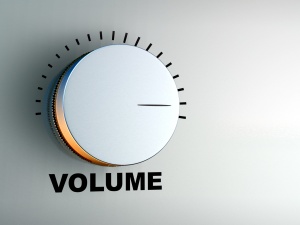 Hearing professionals and parents alike are concerned about the potential for hearing loss from portable music players. If used at high levels for long periods of time, there is increased risk of music-induced hearing loss, tinnitus, hyperacusis and diplacusis.
Hearing professionals and parents alike are concerned about the potential for hearing loss from portable music players. If used at high levels for long periods of time, there is increased risk of music-induced hearing loss, tinnitus, hyperacusis and diplacusis.
Safe Listening Levels
Permissible sound exposures are derived from damage-risk criteria. Sound levels of 85 dB are considered safe for most listeners for less than 40 hours per week (NIOSH, 1998).1 Sound levels that exceed NIOSH recommendations put listeners at increased risk. Equally important is duration of exposure: For every 3-dB increase in sound level, the permissible listening time is cut in half, and these shorter-but-louder exposures are considered to have equal risk: 88 dB is allowed for 20 hours per week; 91 dB is allowed for 10 hours per week and so on. For a complete explanation on allowable exposures and noise dose, read the Explanation of OSHA and NIOSH Safe Exposure Limits white paper.2
Output of portable devices
 Numerous articles have been published on output levels of portable players, but when reading these studies, note the measurement method. Damage-risk criteria were derived from sound level measurements taken with a sound level meter in the sound field, in the absence of the listener. In contrast, output levels of portable players are often measured directly at the earphone, in the ear canal using a probe microphone, or at the
Numerous articles have been published on output levels of portable players, but when reading these studies, note the measurement method. Damage-risk criteria were derived from sound level measurements taken with a sound level meter in the sound field, in the absence of the listener. In contrast, output levels of portable players are often measured directly at the earphone, in the ear canal using a probe microphone, or at the  microphone diaphragm in the ear canal of an ear simulator, making direct comparisons of earphone output levels to damage-risk criteria impossible. Sound levels measured directly at those locations must be corrected by subtracting the transfer function of the open ear.3, 4 If this is not done, the measured values may substantially overstate true risk.4 As a result of all these factors, the wide range of published output values makes it difficult to recommend a “safe” volume setting.
microphone diaphragm in the ear canal of an ear simulator, making direct comparisons of earphone output levels to damage-risk criteria impossible. Sound levels measured directly at those locations must be corrected by subtracting the transfer function of the open ear.3, 4 If this is not done, the measured values may substantially overstate true risk.4 As a result of all these factors, the wide range of published output values makes it difficult to recommend a “safe” volume setting.
Listening habits of teenagers and young adults
 The main reason listeners of all ages turn up the volume on their players is to hear their music over background noise. Earphones that seal the ears block out noise and allow lower playback levels. A study of listening preferences of 29 normal-hearing teenagers (ages 13-17) indicated that chosen levels were significantly lower with insert earphones, and that listening levels were influenced by background noise.5 Likewise, in a study of 100 college students, most chose safe listening levels in quiet, but as background noise increased so did volume levels.6 A key finding in both studies was that when listeners used earphones that sealed the ears, the majority chose safe listening levels regardless of background noise level.5,6
The main reason listeners of all ages turn up the volume on their players is to hear their music over background noise. Earphones that seal the ears block out noise and allow lower playback levels. A study of listening preferences of 29 normal-hearing teenagers (ages 13-17) indicated that chosen levels were significantly lower with insert earphones, and that listening levels were influenced by background noise.5 Likewise, in a study of 100 college students, most chose safe listening levels in quiet, but as background noise increased so did volume levels.6 A key finding in both studies was that when listeners used earphones that sealed the ears, the majority chose safe listening levels regardless of background noise level.5,6
Earphone Design
 The specifications of ETY-Kids earphones are based on careful study of both the maximum voltage output of various portable devices and the maximum output of recordings popular with kids. Current music is mastered considerably higher than the output levels of older recordings, but levels tend to be consistent across artists. These measurements were verified by measuring the output of nominal sensitivity into a sound level meter and then on a personal noise dosimeter connected through a diffuse-field inverse (dfi) filter to the earphone input. Earphone sensitivity was engineered to produce an output level no greater than 88 dB SPL (A-weighted) to achieve a target recommendation of safe listening for four hours a day (20 hours per week) at full player volume. Since ETY-Kids earphones seal the ears, maximum volume is not usually necessary. ETY-Kids earphones are reduced-sensitivity earphones with no circuitry that actively (electronically) limits at a specific level. Sound quality is significantly degraded in that type of design. The result? Safe-listening earphones that sound great!
The specifications of ETY-Kids earphones are based on careful study of both the maximum voltage output of various portable devices and the maximum output of recordings popular with kids. Current music is mastered considerably higher than the output levels of older recordings, but levels tend to be consistent across artists. These measurements were verified by measuring the output of nominal sensitivity into a sound level meter and then on a personal noise dosimeter connected through a diffuse-field inverse (dfi) filter to the earphone input. Earphone sensitivity was engineered to produce an output level no greater than 88 dB SPL (A-weighted) to achieve a target recommendation of safe listening for four hours a day (20 hours per week) at full player volume. Since ETY-Kids earphones seal the ears, maximum volume is not usually necessary. ETY-Kids earphones are reduced-sensitivity earphones with no circuitry that actively (electronically) limits at a specific level. Sound quality is significantly degraded in that type of design. The result? Safe-listening earphones that sound great!
 Patricia Niquette, AuD received her Master’s Degree in Audiology from the University of Iowa and her AuD from Salus University. Her professional experience spans pediatric and educational audiology, industrial hearing conservation, university teaching and private practice. Patty recently completed her term as a Member Delegate on the Executive Council of the National Hearing Conservation Association and serves on the Music-Induced Hearing Loss Committee of NHCA. At Etymotic Research she is involved in research, education, technical writing and new product development.
Patricia Niquette, AuD received her Master’s Degree in Audiology from the University of Iowa and her AuD from Salus University. Her professional experience spans pediatric and educational audiology, industrial hearing conservation, university teaching and private practice. Patty recently completed her term as a Member Delegate on the Executive Council of the National Hearing Conservation Association and serves on the Music-Induced Hearing Loss Committee of NHCA. At Etymotic Research she is involved in research, education, technical writing and new product development.
References
- National Institute for Occupational Safety and Health (1998). Criteria for a recommended standard: Occupational noise exposure. U.S. Department of Health and Human Services, Centers for Disease Control and Prevention.
- Niquette P (2011). Noise Exposure: Explanation of OSHA and NIOSH Safe-Exposure Limits and the Importance of Noise Dosimetry. Etymotic Research, 61 Martin Lane, Elk Grove Village, IL.
- Wiener FM & Ross DA (1946). The pressure distribution in the auditory canal in a progressive sound field. Journal of the Acoustical Society of America, 18: 401–408.
- Berger E, Megerson S, Stergar M (2009). Personal Music Players: Are We Measuring the Sound Levels Correctly? The ASHA Leader, August 11.
- Portnuff CDF, Fligor BJ, Arehart KH (2011). Teenage Use of Portable Listening Devices: A Hazard to Hearing? J Am Acad Audiol 22:663-677.
- Fligor BJ & Ives TE (2006). Does headphone type affect risk for recreational noise-induced hearing loss? Paper presented at the NIHL in Children Meeting, Cincinnati, OH.


































